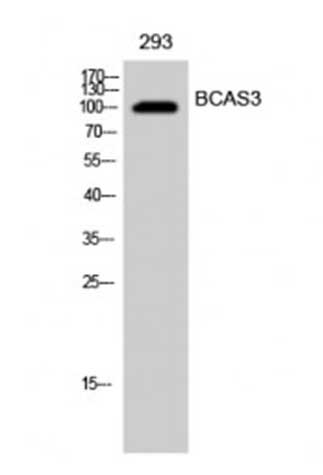Anti-BCAS3 Antibody
Rabbit Polyclonal Antibody
- SPECIFICATION
- CITATIONS
- PROTOCOLS
- BACKGROUND

Application
| WB, E |
|---|---|
| Primary Accession | Q9H6U6 |
| Reactivity | Mouse |
| Host | Rabbit |
| Clonality | Polyclonal |
| Isotype | Rabbit IgG |
| Clone Names | N/A |
| Calculated MW | 101237 Da |
| Gene ID | 54828 |
|---|---|
| Application & Usage | WB: 293 cells |
| Other Names | Breast carcinoma-amplified sequence 3, GAOB1 |
| Target/Specificity | BCAS3 |
| Antibody Form | Liquid |
| Appearance | Colorless liquid |
| Formulation | In PBS containing 50% glycerol, 0.5% BSA and 0.02% sodium azide |
| Handling | The antibody solution should be gently mixed before use. |
| Reconstitution & Storage | -20 °C |
| Background Descriptions | |
| Precautions | Anti-BCAS3 Antibody is for research use only and not for use in diagnostic or therapeutic procedures. |
| Name | BCAS3 {ECO:0000312|HGNC:HGNC:14347, ECO:0000312|MIM:607470} |
|---|---|
| Function | Plays a role in angiogenesis. Participates in the regulation of cell polarity and directional endothelial cell migration by mediating both the activation and recruitment of CDC42 and the reorganization of the actin cytoskeleton at the cell leading edge. Promotes filipodia formation (By similarity). Functions synergistically with PELP1 as a transcriptional coactivator of estrogen receptor- responsive genes. Stimulates histone acetyltransferase activity. Binds to chromatin. Plays a regulatory role in autophagic activity. In complex with PHAF1, associates with the preautophagosomal structure during both non-selective and selective autophagy (PubMed:33499712). Probably binds phosphatidylinositol 3-phosphate (PtdIns3P) which would mediate the recruitment preautophagosomal structures (PubMed:33499712). |
| Cellular Location | Nucleus. Cytoplasm. Cytoplasm, cytoskeleton {ECO:0000250|UniProtKB:Q8CCN5}. Preautophagosomal structure. Note=Localizes in the cytoplasm in stationary cells. Translocates from the cytoplasm to the leading edge in motile cells. Colocalizes with microtubules and intermediate filaments in both stationary and motile cells (By similarity) Associates with chromatin. Recruited to estrogen receptor-induced promoters in a PELP1-dependent manner. The BCAS3:PHAF1 complex is recruited to the preautophagosomal structures adjacent to the damaged mitochondria upon mitophagy in a PRKN-PINK1 dependent manner (PubMed:33499712). {ECO:0000250|UniProtKB:Q8CCN5, ECO:0000269|PubMed:17505058, ECO:0000269|PubMed:33499712} |
| Tissue Location | Expressed in stomach, liver, lung, kidney, prostate, testis, thyroid gland, adrenal gland, brain, heart, skeletal muscle, colon, spleen, small intestine, placenta, blood leukocyte and mammary epithelial cells. Expressed in undifferentiated ES cells Expressed in blood islands and nascent blood vessels derived from differentiated ES cells into embryoid bodies (BD). Expressed in endothelial cells. Not detected in brain. Expressed in brain tumors (at protein level). Expressed in brain. Highly expressed in breast cancers and in glioma cell lines. |

Thousands of laboratories across the world have published research that depended on the performance of antibodies from Abcepta to advance their research. Check out links to articles that cite our products in major peer-reviewed journals, organized by research category.
info@abcepta.com, and receive a free "I Love Antibodies" mug.
Provided below are standard protocols that you may find useful for product applications.
Background
Plays a role in angiogenesis. Participates in the regulation of cell polarity and directional endothelial cell migration by mediating both the activation and recruitment of CDC42 and the reorganization of the actin cytoskeleton at the cell leading edge. Promotes filipodia formation (By similarity). Functions synergistically with PELP1 as a transcriptional coactivator of estrogen receptor-responsive genes. Stimulates histone acetyltransferase activity. Binds to chromatin
If you have used an Abcepta product and would like to share how it has performed, please click on the "Submit Review" button and provide the requested information. Our staff will examine and post your review and contact you if needed.
If you have any additional inquiries please email technical services at tech@abcepta.com.













 Foundational characteristics of cancer include proliferation, angiogenesis, migration, evasion of apoptosis, and cellular immortality. Find key markers for these cellular processes and antibodies to detect them.
Foundational characteristics of cancer include proliferation, angiogenesis, migration, evasion of apoptosis, and cellular immortality. Find key markers for these cellular processes and antibodies to detect them. The SUMOplot™ Analysis Program predicts and scores sumoylation sites in your protein. SUMOylation is a post-translational modification involved in various cellular processes, such as nuclear-cytosolic transport, transcriptional regulation, apoptosis, protein stability, response to stress, and progression through the cell cycle.
The SUMOplot™ Analysis Program predicts and scores sumoylation sites in your protein. SUMOylation is a post-translational modification involved in various cellular processes, such as nuclear-cytosolic transport, transcriptional regulation, apoptosis, protein stability, response to stress, and progression through the cell cycle. The Autophagy Receptor Motif Plotter predicts and scores autophagy receptor binding sites in your protein. Identifying proteins connected to this pathway is critical to understanding the role of autophagy in physiological as well as pathological processes such as development, differentiation, neurodegenerative diseases, stress, infection, and cancer.
The Autophagy Receptor Motif Plotter predicts and scores autophagy receptor binding sites in your protein. Identifying proteins connected to this pathway is critical to understanding the role of autophagy in physiological as well as pathological processes such as development, differentiation, neurodegenerative diseases, stress, infection, and cancer.


